Chip in Now to Stand Up for Working People
Working people need a voice more than ever and Working America is making that happen.
Working people need a voice more than ever and Working America is making that happen.

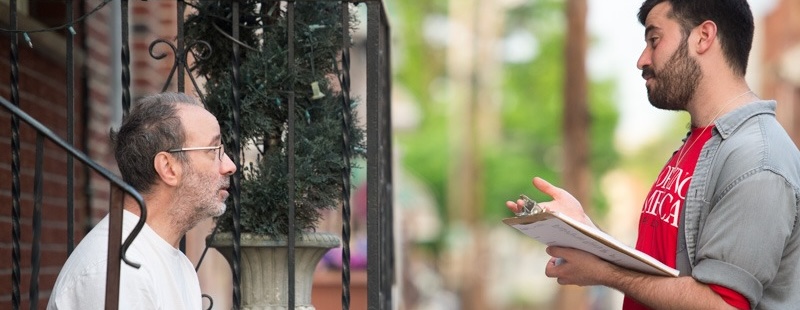
03/15/2017
OVERVIEW
Just days after Donald Trump won enough Electoral College votes to become president, Working America went back into the field to visit some of the communities where we had worked in 2016. We talked with working-class voters, both Hillary Clinton and Trump supporters, to learn how they were feeling in the wake of the election, and what their expectations were for the future. More than a third of the conversations were return visits to people we had spoken with prior to the election.
What our front-porch conversations revealed was that working-class voters are as worried and confused as they were prior to November. Regardless of who they voted for, these individuals remain uncertain about their futures, unclear about the role of government, anxious about a nation that seems more divided than ever, and searching for a viable path forward. Many were swing voters before the election, and they remain in flux today.
Although much of Trump’s campaign was infused with virulent racism and misogyny, we saw fissures in his support, and dissipating tolerance for his brash style. Two-thirds of Trump voters opposed components of the agenda he’s espoused, and voters across the board said they are looking to him to change his rhetoric and heal the country. That is the challenge and the opportunity for progressives.
Over three weeks, from Nov. 21 through Dec. 9, 2016, Working America canvassers spoke with 2,355 voters in five battleground states—Florida, Missouri, North Carolina, Ohio and Pennsylvania, generally focusing on swing communities in the suburbs and exurbs. We asked our canvassers to listen carefully, engage thoughtfully, and to reflect on what they heard.
Of the voters we canvassed, 93 percent reported voting in the 2016 election. Of the people who told us who they voted for, 56 percent told us they voted for Hillary Clinton, and 37 percent said they voted for Donald Trump. Seven percent of the people we talked with voted for a third party candidate. The vast majority of people we spoke with were white (83 percent); 10 percent were black and 6 percent were Latinx. Overall, the breakdown between women and men was 54 percent women and 46 percent men. White voters made up 95 percent of Trump’s support in our sample. Five percent of Trump supporters were people of color. Among this segment, 4 percent were Latinx and 1 percent was black.
KEY FINDINGS
Little Elation, Lots of Caution
In the wake of the election, Clinton voters were shocked, angry and afraid, sometimes to the point of tears, although the feelings seemed to mutate more toward despair and resignation as the weeks passed. A quarter of voters of color said they are fearful of losing ground because of one-party conservative rule, where 1 in 5 whites expressed the same sentiment. Fully 39 percent of Clinton voters rejected everything about the Trump agenda.
“Trump’s not interested in protecting everyone’s rights. His rhetoric divided Americans…He pitted us against each other.” Clifton, a 46-year-old black voter from Philadelphia
“If you lived off of Social Security and Medicare, you’d know how bad I feel.” James, a 71-year-old white Clinton supporter in Columbus
“I’m worried Trump will ‘flip the switch’ and take away citizenship from Puerto Ricans like me because they’re categorized as Latinos, and Trump thinks all Latinos are criminals.” A 64-year old Latinx woman in Orlando
“As an Indian-American, I obviously care about my fellow immigrants that moved here to find the American Dream…When Trump won, my classroom and myself felt as though the world may come to an end.” Santi, a 45-year-old teacher in the Cleveland suburbs who voted for Clinton
“My wife and I wished Bernie had won the nomination for president. He had our heart….Trump may not be the devil himself but he regularly makes deals with the man downstairs. My wife and I are expecting a baby, and I want to fight to make sure our child doesn’t grow up in a world of hate.” Donald, 38, a Clinton voter from Columbus
More surprisingly, many Trump supporters seemed startled that he had won. While some Trump supporters expressed delight at his victory, many were wary of him but saw him as the only possibility for economic change. They often expressed reservations about parts of his agenda. While a third of Trump supporters we spoke with could be characterized as “lock her up” voters who backed his entire platform, two-thirds expressed some objections when we asked, “Is there anything you disagree with Trump on?”. More than 1 in 5 Trump voters said his hateful rhetoric was a problem and 15 percent disagreed with his most extreme ideas on immigration, like building a wall or deporting undocumented workers. As one of our canvassers reported, “When I commented to one Trump voter that he had won, he looked me straight in the eyes and very softly and soberly said, ‘None of us won.’”
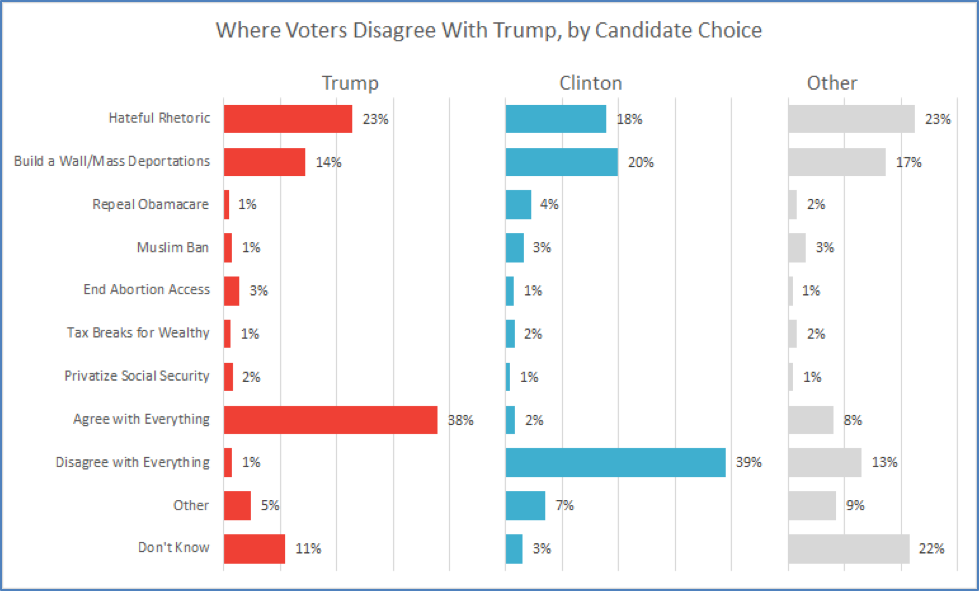
Canvassers characterized Trump voters’ views in this way:
Jessica, 39, from Philadelphia, said she voted for Trump because she believes that we need jobs that rebuild the middle class. At the same time, she doesn’t think there should be low- wage jobs and disagreed with Trump’s rhetoric. I asked her how she was able to look past the rhetoric and still vote for him. She replied that she is “old school,” and she’s used to that kind of talk and believes he will follow through on the policies that he talked about. She brought up the ACA in our conversation, saying she does not believe it should be dismantled, but the rising costs need to be addressed and fixed. She also added that Working America should keep doing what we are doing, engaging people in the community and doing more of it.
Kacy, 27, from Pittsburgh, was an ardent Trump supporter who was looking for a major change in political leadership. She remarked, “Trump is an asshole, but sometimes you need an asshole to make things better and shake things up.”
Joe, 70, from the St. Louis, Missouri, area, voted for Trump but acknowledged that he’s “said some ridiculous things, which made it tough for me to be a strong supporter.” He revealed his concern with Trump’s approach when he said that national security is important, but problems can’t always be fixed with military might.
While fewer than 20 percent of voters we spoke with were people of color, there were some notable similarities and differences with white voters that emerged in their reaction to the election and Donald Trump. Voters of color and white voters largely agreed that Trump should stop his hateful rhetoric. But on the racially-laden issue of building a wall and mass deportation, voters of color were more concerned about Trump’s plan than white voters. There was also a substantial share of voters who either disagreed or agreed with Trump about everything; however, that tended to correlate with being committed partisans for either Clinton or Trump.
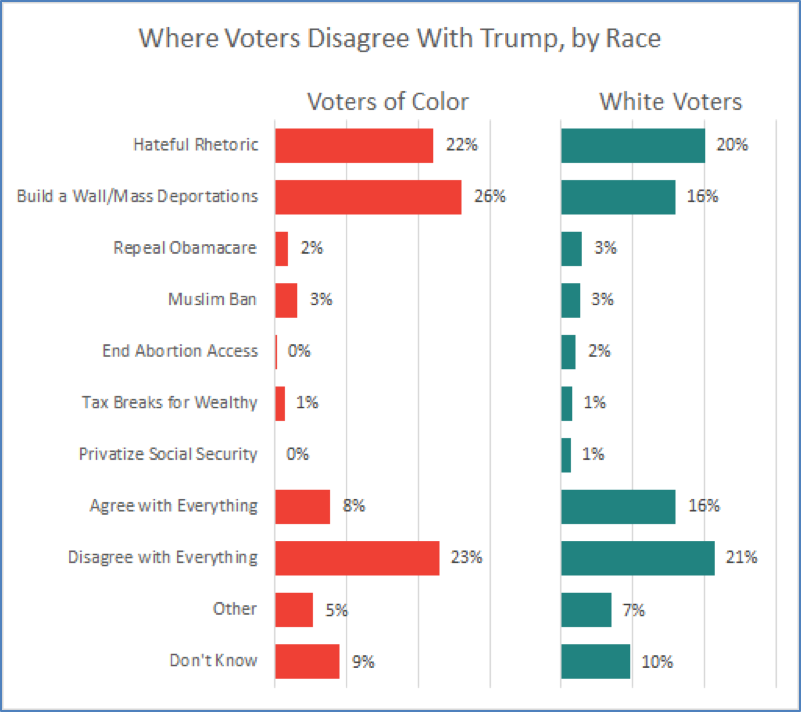
Looking at where voters disagreed with Trump by gender, we see both commonalities and divergences as well. Women were slightly more likely than men to disagree with Trump’s use of hateful rhetoric or disagree with everything. Men were more likely than women to disagree with Trump on building a wall and mass deportations and more likely than women to agree with everything in Trump’s agenda.
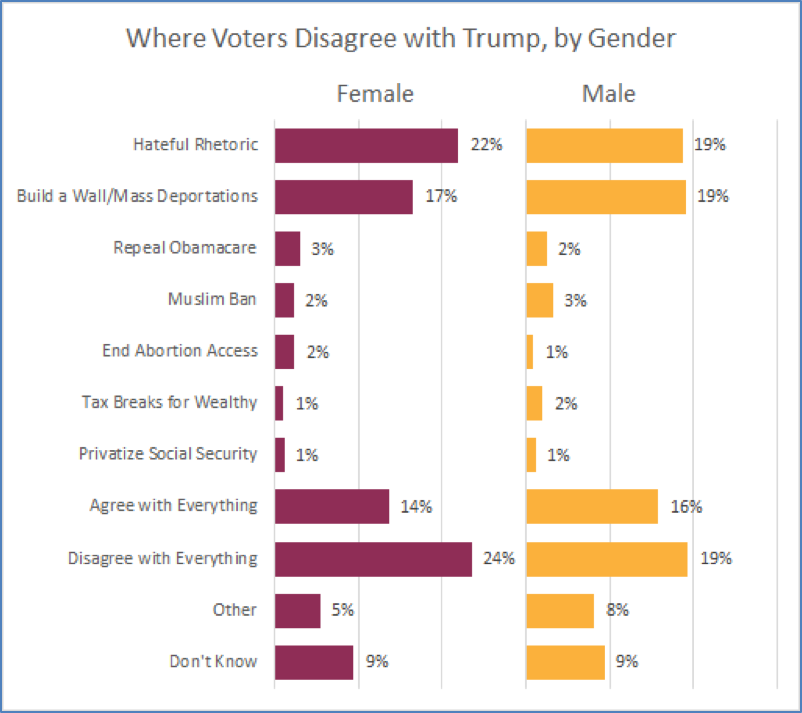
Division and Convergence
Of the people with whom we spoke, 63 percent thought the country was more divided now than before the election, while only 5 percent thought it was more united. While overall 15 percent of voters agreed with Trump on everything, when we looked at just Trump voters, that support increased to 38 percent. By contrast, 22 percent of voters disagreed with Trump on everything, and when we look at Clinton voters, that number increases to 39 percent. Trump voters were more likely than Clinton voters to say things were pretty much the same before and after the election; Clinton voters felt the chasm somewhat more keenly. Some voters of color expressed that the election had merely forced existing divisions into the light.
We asked voters what their top concern was prior to casting their ballot. Trump voters overwhelming prioritized jobs and the economy while “stopping Clinton” came in second at 16 percent. Those priorities were flipped in the case of Clinton voters, where 33 percent prioritized either “stop Trump” or “elect a competent president,” and jobs and the economy came in second at 17 percent.
However, despite the overwhelming feeling of a country divided, Clinton and Trump voters had remarkably similar concerns moving forward. When we asked them what should Trump tackle first, working people across the spectrum identified jobs and the economy as a top priority, with ending hateful rhetoric/healing the divide in second place. Clinton voters were more focused on Trump changing his rhetoric than Trump voters. Trump voters were more focused on addressing the economy than Clinton voters.
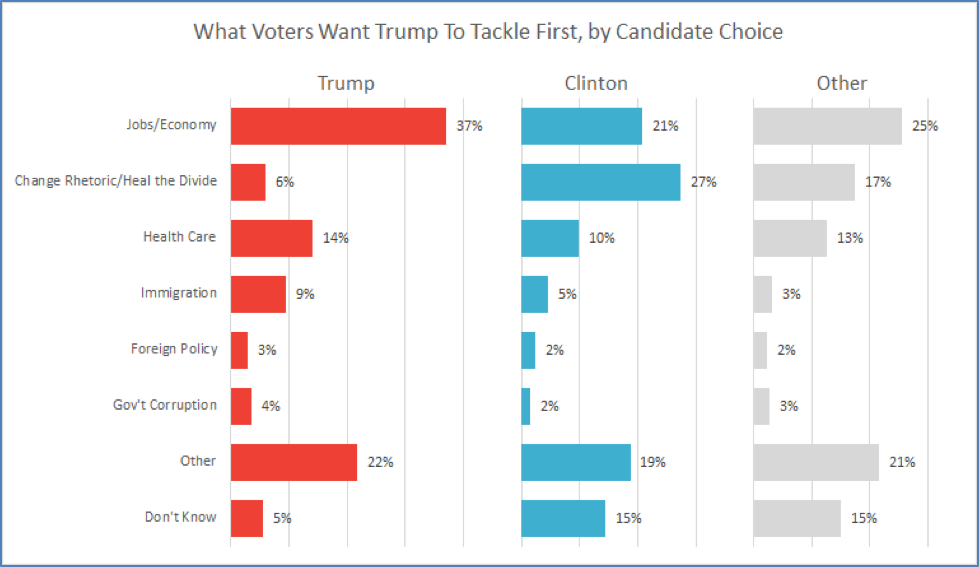
While there were differences in what voters disagreed with Trump on based on gender, we found consistent agreement across gender on what he should prioritize.
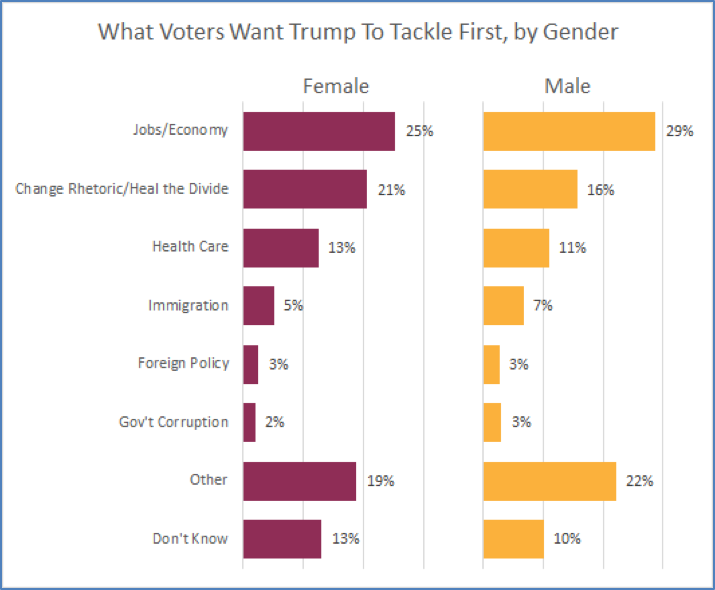
For voters of color versus white voters, there was largely agreement on top priorities—jobs and changing Trump’s rhetoric and healing the divide. We started to see divergence on health care, which was more important to white voters, and immigration, which was more important to voters of color. For context, Trump won 10 percent of the voters of color we canvassed.
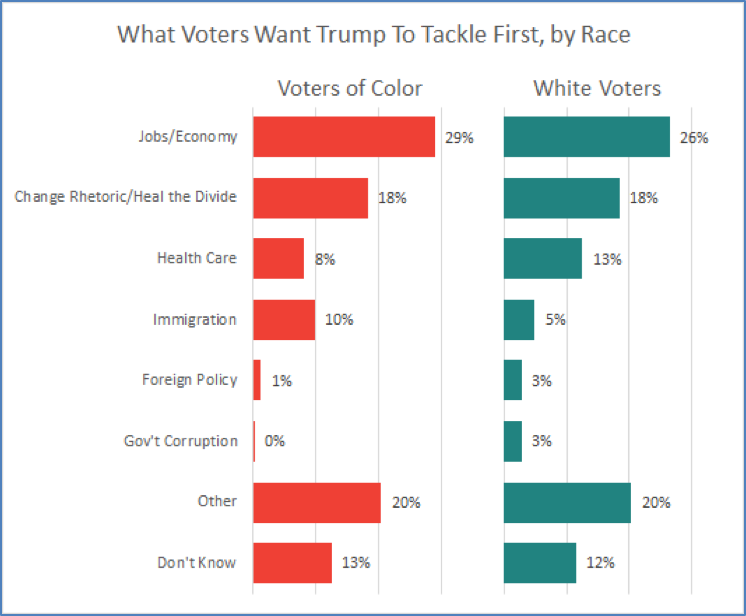
Cynicism about Politicians, Confusion about Government
The convergence of Clinton and Trump voters was especially pronounced when we probed their views about politicians. Voters deemed most politicians unresponsive, citing that they were: out of touch (Clinton: 23 percent / Trump: 26 percent / Other: 26 percent); corrupted by money in politics (Clinton: 22 percent / Trump: 19 percent / Other: 22 percent); and said one thing but then did another (Clinton: 13 percent / Trump: 10 percent / Other: 9 percent).
Darren, a 44-year-old white man in South Philadelphia, voted for Trump, albeit reluctantly, because Trump is a businessman with money. He believes that all politicians are out of touch with regular voters and hopes that as an outsider Trump will pay attention to issues like domestic poverty and child hunger. Darren said that because regular people do not have money “we mean nothing” to the people leading our government.
Retired teacher Rhonda, a 57-year-old white woman in Reynoldsburg, Ohio, a suburb east of Columbus, stated that even though she is pro-choice and supports marriage equality, she voted for Trump based on the greater need for change from politics as usual in Washington, D.C., adding that she wanted to send a message to career politicians who have helped create a government that no longer works for all Americans.
Likewise, Clinton and Trump voters held the same bafflement about the role of government. Canvass staff reported that many voters initially had a negative response simply to the word “government.”
And although they sometimes needed help in identifying what programs the government actually provided, many of those same people also valued Social Security and Medicare, public education, and even the Affordable Care Act.
John, 44, from Cleveland, voted for Trump. He has been voting Republican lately because, he said, “Government should not do much besides protect its citizens.” He is upset about handouts for people he thinks don’t deserve them. “Trump was outside the box and not a politician. If he messes things up then we can get rid of him in four years. We need to raise the minimum wage.” He thinks there are a lot of good things about Obamacare. “Hillary would have done nothing new, just more of the same.”
The number of Trump voters who wanted to fix rather than repeal the ACA is notable, especially in light of the current policy debates.
“Most people don’t know the intricacies of the ACA,” said a canvasser in Pittsburgh. “What they tend to focus on is that it ‘didn’t fix health care.’ People continue to see their premiums or contributions increase and they see this as a failure of the reforms. There’s also the feeling that it was another example of “the rich already had great health care” and “poor people got free health care” but the costs for the middle class keep rising and with flat wages it contributes to a feeling of stagnation in general. Most people don’t really know what pieces were good or bad, only that their rates are continuing to go up.”
Internal Contradictions
Time and again, we encountered people who held contradictory or conflicting concepts in tandem. One of the clearest examples was the woman in western Pennsylvania who ultimately voted for Trump because she hoped he’d bring well-paying jobs in the coal industry back to the region, while at the same time she was deeply concerned that the Trump agenda might harm the environment.
A 65-year-old woman in a Cleveland suburb who voted for Trump, was “very upset with refugees entering our country and taking away opportunities from Americans. Look at those apartments over there. They are filled with refugees, and they don’t pay taxes and are freeloading off of me and you!” But she supports universal health care and protecting Social Security. “I was with Trump from the very beginning. He is the solution.”
Daren and Amanda, a white couple in their mid-30’s living outside of Columbus, had previously supported Obama but voted for Trump out of disappointment with increasing health care costs they believed were being driven by the ACA. However, both voters said they disagree with Trump’s stance on immigration, and were troubled by the racist bigotry coming from Trump and his campaign.
Melinda, 44, and Brian, 48 are both pastors at a Christian college in North Carolina. Both Trump voters, they said that their top issue was “sanctity of life” but neither was happy to vote for Trump. As Melinda put it, “I don’t agree with how Hillary stood on abortion, but I also don’t agree with Trump wanting to blow people up. Really, I voted for Pence.” About Trump, she said, “He’s a mess.” Then she caught herself, sighed, and said, “I guess I shouldn’t say that. He is our president.” They both felt like something needed to be done about health care costs and expressed support for universal health care.
Desperate for Change, Searching for Solutions
“People voted for change, even if they don’t know what change will look like. They rolled the dice hoping for change.” Canvasser in St. Louis
Across the political spectrum, we discovered that, as was true before the election, many working people craved good jobs and a fair economy more than walls and deportations. They wanted health care to be more affordable, but didn’t necessarily want to see Obamacare repealed. They wanted industrial jobs to return, but also worried about climate change. They were leery about government, but adamant that lawmakers should not privatize Social Security and Medicare. Most saw the country as more divided than before, and many were concerned about the rhetoric of bigotry.
Yet in the end, the desperation for economic change and the feeling of being abandoned by the flow of “politics as usual” overrode unease with some of the specific policies floated by Trump and his racist rants and volatile temperament during the election cycle. Frequently, they cited the impossibility of envisioning any useful change with Clinton.
A retired 66-year-old white woman in Reynoldsburg, Ohio, a suburb east of Columbus, said she was drawn to Trump because he is not a politician, and ended up voting for him because she likes his policies (though not his rhetoric). She used to be a Democrat, but said she was upset that nothing has gotten done – she’s frustrated with Common Core and the ACA, and feels that the high cost of health insurance combined with low wages will not incentivize families to pull themselves out of poverty and off government welfare programs. She began to cry, because she’s not sure what to do next and wants to heal the divide she sees in the country.
Taken in the aggregate, the conversations our field canvass conducted suggest that many Trump voters we spoke with were not hate-filled violent rally-goers. Rather, they were people trying to make ends meet against some formidable systemic odds. They were people who prioritized perceived economic self-interest over blatant racism and sexism in the hopes of better economic fortunes. In addition, they are unclear about what government actually does, and the relationship between various policies and outcomes. They are largely unable to connect the dots between “lower taxes” and “smaller government” and the crises they perceive in their schools, their infrastructure and their health care.
Regardless of how they cast their votes, a significant segment of working-class people are still searching for the policy solutions that will improve the economy for their families and their communities. When we asked what they planned to do next, a quarter said they intended to be better informed, indicating a desire for good information. A third of the people with whom we spoke joined Working America. Of the new members, 67 percent were Clinton supporters, but 17 percent voted for Trump, including 47 voters who “agree with him about everything.”
Above all, we learned that even after such a contentious election, the vast majority of voters were eager to talk, and often thanked our canvassers for being back out so soon after the election. It was also clear after 2,355 conversations that, as progressives, we have our work cut out for us.
METHODOLOGY
Unlike traditional public opinion polling, which is based on randomly sampled people intended to be representative of a given population, we targeted working-class neighborhoods in five battleground states, with 63% of the people we spoke with from households making $75,000 or less. Our sample is not representative.
Of the voters we canvassed, 93 percent reported voting in the 2016 election. Of the people who told us how they voted, 52 percent said they voted for Hillary Clinton and 35 percent said they voted for Donald Trump. Seven percent of the people we talked with voted for a third-party candidate, and 7 percent didn’t vote. Ten percent of the voters we reached did not want to share their vote choice.
As far as a demographic breakdown, the canvassed populations skewed female over male (54 percent to 46 percent), but was distributed evenly across age groups (no age group made up more than 20 percent of the overall composition). The vast majority of people we spoke with were white (83 percent); 10 percent were black and 6 percent were Latinx. White voters made up 95 percent of Trump’s support in our sample. Of the people of color who voted for Trump, 4 percent were Latinx and 1 percent was black.
Conversations ranged from a few minutes to as long as 15 minutes. Canvassers sought to gauge how voters were feeling and how they had made their political choices on Nov. 8, 2016. Individuals we canvassed could choose not to answer a specific question, which resulted in slightly different totals for each response.
We deployed canvass teams in the following cities and congressional districts:
Cities Canvassed:
Cleveland, OH,
Columbus, OH
Orlando, FL
Philadelphia, PA
Pittsburgh, PA
Raleigh, NC
St. Louis, MO
Congressional Districts Canvassed:
Florida: CD-7, CD-9, CD-10
Missouri: CD-1, CD-2
North Carolina: CD-4, CD-13
Ohio: CD-3, CD-8, CD-9, CD-10, CD-12, CD-15
Pennsylvania: CD-1, CD-2, CD-8, CD-12, CD-13, CD-14, CD-18
We use cookies and other tracking technologies on our website. Examples of uses are to enable to improve your browsing experience on our website and show you content that is relevant to you.